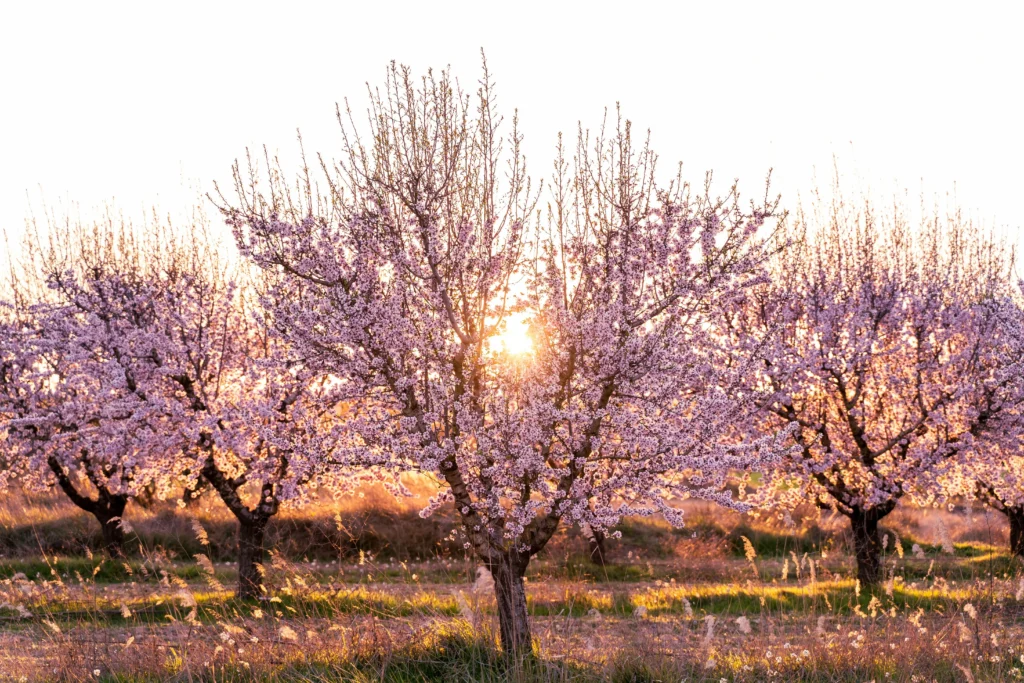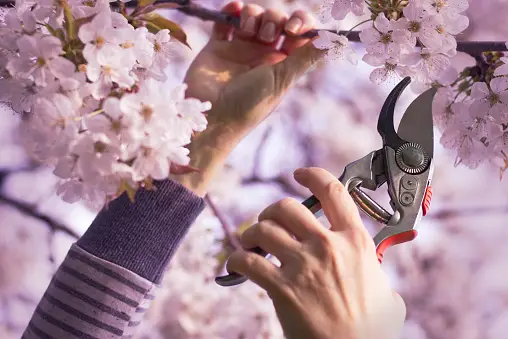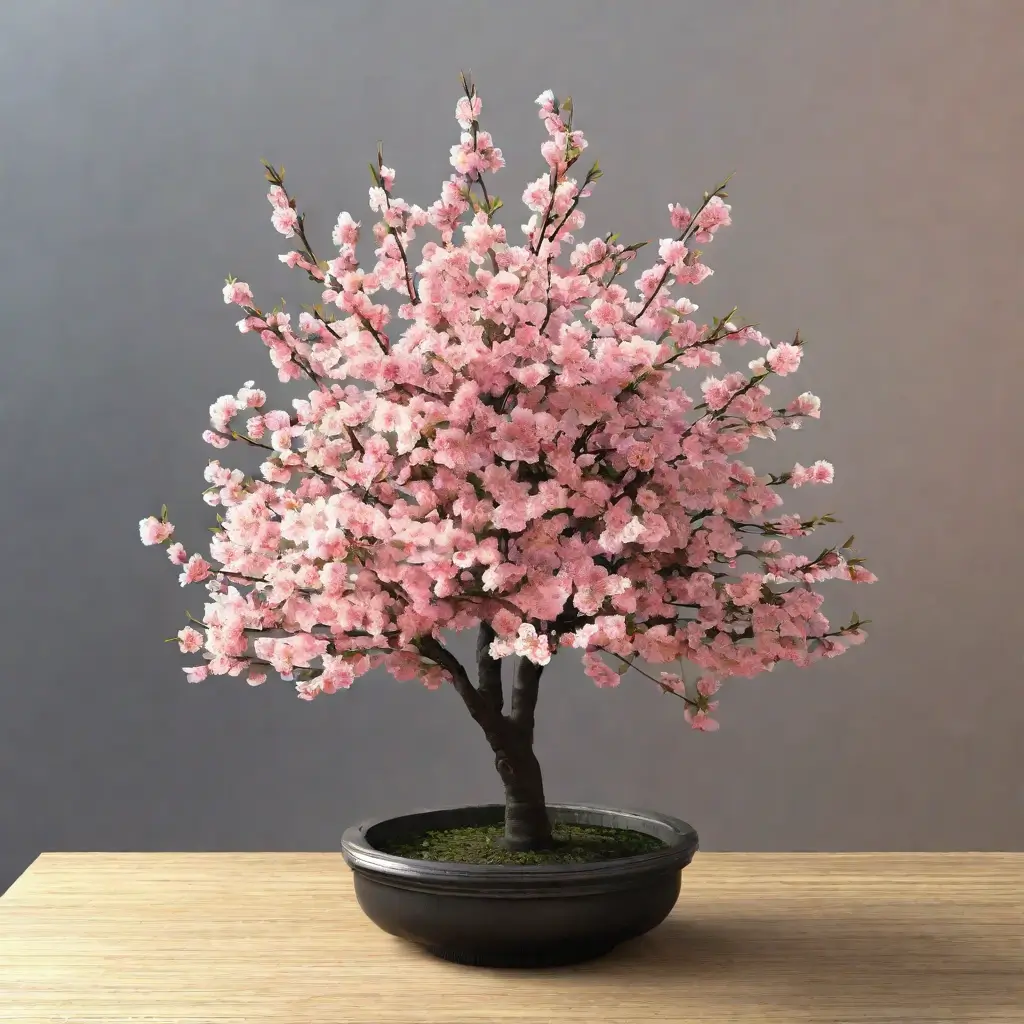Cherry blossom trees, with their gorgeous pink and white blooms, are adored the world over. While they have close associations with Japanese culture, cherry blossom trees (Prunus) can thrive in gardens all across the United States as well.
Many gardeners dream of having one of these ornamental wonders in their own outdoor space. But what if you don’t have an open yard or the proper in-ground conditions? Can you grow cherry blossom trees in pots?
The good news is yes – with the right setup and care, you can successfully grow miniature cherry trees on your patio or porch in containers. This guide covers everything you need to know, from choosing the best varieties to proper watering techniques. Read on to learn the secrets to nurturing potted cherry blossoms!
Reasons to Grow Cherry Blossoms in Pots
Beyond aesthetic appeal, there are some key practical reasons you may want to grow these stunning trees in containers rather than directly in the ground:
- Limited garden space: Potted trees are perfect for small gardens, courtyards, balconies and patios where planting space is at a premium.
- Portability: Container-grown cherry blossom trees can easily be moved around your outdoor space to capture the best light conditions or for design purposes.
- Avoid invasive roots: Left uncontained, cherry tree roots can spread aggressively and potentially damageother garden infrastructure like patios. Growing them in pots prevents this.
- Easier care & maintenance: You have more control over soil quality, watering and drainage in a potted environment. This allows you to better meet the tree’s needs.
If any of these factors appeal to you, planting your cherry blossom tree in a container is likely an excellent choice.
Choosing the Right Pot for Cherry Trees
Your container is the foundation for successfully growing cherry blossoms on your patio or porch. Here are key considerations when selecting pots:
- Size: Go big! Cherry tree roots need ample room to spread out, so choose wide, deep containers. Aim for at least 15-20 inches in diameter and depth. This gives sufficient space for early root development.
- Material: Terracotta, ceramic and thick plastic pots are suitable options:
- Terracotta naturally breathes, allowing air exchange through the material. This can help prevent overly soggy soil.
- Ceramic holds moisture well in hot climates and comes in various decorative styles.
- Plastic is affordable but be sure to pick a sturdy variety that will cope with years of soil, watering and seasonal movement.
- Drainage holes are an absolute must. Cherry trees will not survive in waterlogged soil, so your container requires openings at the base to allow excess moisture to escape.
The Best Soil Mix for Potted Cherry Blossoms
To provide essential nutrients and moisture control, the soil quality for container cherry trees is critical.
Here are tips for the ideal soil mix:
- Potting mix: Use a commercial soil blend specifically formulated for containers instead of garden soil. This will ensure excellent drainage.
- Aerate with compost: Mix in 1⁄3 part compost to further lighten the soil texture. Things like aged bark, coconut coir and worm castings work wonderfully.
- Check pH level: Cherry blossoms prefer neutral to slightly acidic soil with a pH between 6.0-7.0. Test kit strips are inexpensive and take the guesswork out.
- Add slow-release fertilizer: Incorporate some pelletized fertilizer when first potting to fuel initial growth. Osmocote® or Dynamite® are recommended options.
Following this basic recipe will give your potted cherry tree the kind of loamy, nutrient-rich environment it thrives in.
Best Cherry Tree Varieties for Growing in Containers
Wild cherry trees can reach towering 60 foot heights – far too large for pot culture! Instead seek out compact ornamental cultivars specifically bred for smaller spaces.

Some top picks include:
- ‘Yoshino’ – The quintessential flowering cherry tree. White blooms and reddish bark. Grows to 15 feet.
- ‘Kanzan’ – Abundant pink double blossoms. More heat tolerant. Max height around 13 feet.
- ‘Holo-higo’ – Earlier flowers than some varieties. Maxes out under 10 feet.
- ‘Shirofugen’ dwarf – Vase-shaped form and vibrant pink blooms. Slow growing to 8-10 feet.
There are over a hundred cherry blossom tree cultivars, but these tend to work particularly well scaled down to container size. Be sure to note expected maximum heights and widths when researching specific varieties.
Providing the Proper Light Conditions
Ample sunlight is crucial for lush flowers and avoiding leggy, uneven growth. Potted cherry blossom trees need at full 6 hours of direct sun daily.
If anything, more sun is preferable to less. Without enough light exposure, your tree will struggle to thrive. It may slowly decline over years as it exhausts resources trying to bloom and fruit.
When positioning your container cherry tree, also be mindful of intense afternoon sun in hot climates. If subjected to hours of direct midday rays without relief, leaves can scorch. Find a spot that offers a balance of ample morning light and afternoon shade.
And if you live in a region with harsh winters, also factor sheltered locations into your planning. That bright southern exposure perfect for growing needs may become problematic when icy winds blow! We’ll cover overwintering protection tips a bit later on.
Watering Needs and Fertilizer for Potted Cherry Trees
Vigilant watering and nutrient monitoring are both essential in container culture. When grown in the ground, trees develop deep root systems to tap water stored well below the surface. But potted specimens rely completely on what you provide from above.
Here are best practices to follow for irrigation and fertilization:
Watering Frequency Differs from Ground Plantings
- Check soil moisture daily during the growing season – Container plants dry out much faster than in-ground trees. Never let potting mix totally dry out.
- Water thoroughly until it runs from drainage holes. Take care not to blast delicate surface roots with an overly forceful spray though.
- Allow soil to partially dry out between waterings. Saturated soil suffocates roots and encourages rot over time.
- Increase frequency during flowering and fruiting times when water needs are highest.
- Consider inexpensive self-watering orb attachments to maintain even moisture levels.
Fertilize Regularly During the Growing Season
- In spring, begin light feedings with a balanced liquid fertilizer like 20-20-20 or fish emulsion.
- Every 4-6 weeks through summer and fall, fertilize potted cherry trees to fuel growth. Reduce applications for winter dormancy.
- Alternate between liquid fertilizer and slow-release pellet formulations for full spectrum coverage.
- Watch for signs of nutrient deficiencies like yellowing leaves or stunted branches. Diagnose and adjust your regimen accordingly.
With attentive care in these areas, your container-grown blossom tree will flourish season after season. But that nurturing must continue year-round…
Protecting Cherry Trees in Pots Through Winter
Cherry trees require a period of winter chill with sub-freezing temperatures to properly set flower buds for the coming spring. But potted specimens are more vulnerable to harsh cold compared to their counterparts firmly rooted in the insulating earth.
Additional protection measures are advised for container-grown trees depending on your climate conditions:
- Move pots close together in a sheltered location. Grouped plantings shield one another from bitter wind and radiate warmth.
- Wrap containers with burlap, straw, bubble wrap or insulation sheets. This mimics earth’s natural insulation.
- Place an outdoor plant jacket over the entire pot if temperatures drop below 15° Fahrenheit.
- For drastic cold, supplement with heat lamps, electric heating cables in the soil or move pots into an unheated garage temporarily.
Your goal is simply keeping root zones above damaging temperatures while still allowing the required winter chill. With a little seasonal attention, your potted cherry blossoms will sail through winter ready to explode into fabulous flower come spring!
Pruning and Other Care for Container Cherry Blossom Trees

To maintain compact growth suited to pots plus support fruit production, annual pruning is extremely beneficial:
- In late winter/early spring when the tree is still dormant, thin inner branching to open up airflow and light penetration to the canopy.
- Remove any dead, damaged or crossing/rubbing branches.
- Shorten overly-long limbs but don’t remove more than 1⁄3 of total growth to avoid stressing the plant.
- Make pruning cuts just above outward facing buds to direct expansion away from the center.
- Disinfect pruning tools between trees with diluted bleach to prevent disease transmission.
Beyond attentive pruning, a few other care notes for container-grown cherry blossoms:
- Check often for pests like aphids or mites and treat promptly before populations explode.
- Watch for signs of disease like leaf spot fungus. In containers, it’s essential to catch issues early before they rapidly spread through soil or root contact. Remove and destroy affected plant material immediately.
- Repot every 2-3 years in fresh potting mix amended with slow release fertilizer. Cherry trees are sensitive about root disturbance so choose timing carefully around growth cycles.
- Manage your expectations on tree size – Container specimens often max out at 75% the size of their in-ground counterparts depending on pot dimensions. But smaller scale trees bloom profusely when cared for properly!
Where to Place Potted Cherry Trees for Maximum Impact
A cherry blossom in full riotous flower against a neutral background is a sight to behold. Plan your container placement carefully for best effect:
- Position pots where prevailing breezes will shower petals down around the trees like snow for a magical effect.
- Frame focal points in your garden by using pairs of matching trees to mark important intersections or boundaries.
- Flank entryways with matching specimens to welcome guests with a burst of color.
Take photos and monitor growth over the seasons. You may need to shift pots around for ideal shape fills and framing as trees mature.
With robust health and strategic placement, your potted cherry blossoms will stop visitors in their tracks when the blooms burst open each spring!
Key Takeaways: Top Tips for Growing Cherry Trees in Containers
To conclude this complete guide, here are top tips to remember:
- Select wide, deep containers with drainage holes
- Use rich, loamy potting mix amended with compost
- Choose compact flowering cherry tree varieties sized for pots
- Provide a minimum of 6 hours direct sunlight daily
- Water thoroughly when surface soil dries out
- Apply balanced fertilizer regularly in the growing season
- Protect pots from harsh winter wind and cold
- Prune annually in late winter to shape growth
- Check often for pests/diseases and treat quickly
- Repot every few years into fresh soil mix
Follow this advice and your beloved cherry tree will flourish happily on your patio or porch for years of enchanting spring blooms to come. For additional tips or inspiration, explore the resources below. Happy growing!
